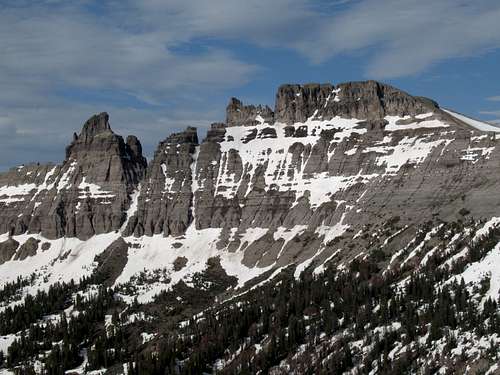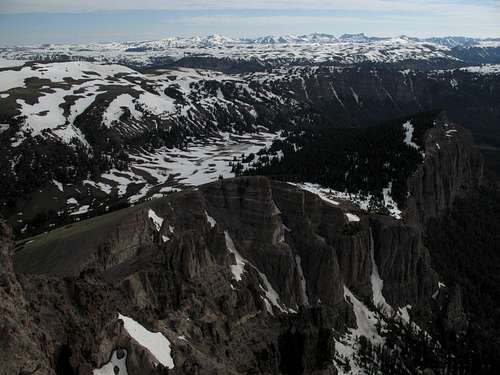-
 5737 Hits
5737 Hits
-
 84.82% Score
84.82% Score
-
 19 Votes
19 Votes
|
|
Mountain/Rock |
|---|---|
|
|
43.76371°N / 109.95494°W |
|
|
Mountaineering |
|
|
Summer |
|
|
11245 ft / 3427 m |
|
|
Overview-- Pinnacle Butte NE
At 11,245', Pinnacle Butte NE is the second-highest of the five main summits of the Pinnacle Buttes. It is not technically difficult to climb, though it looks so from certain perspectives, but reaching the summit requires a ridgewalk with extreme exposure if, as you should, you walk along the edge to appreciate the views and sheer drops inches away, and there are sections of Class 3 scrambling in the summit area, including on the summit block itself.
There are decent views of the peak between it and Dubois along U.S. 287, but the mountain is really best viewed from the trail and from neighboring summits.
On some maps, this peak is labeled as "Pinnacle Buttes North."
There are decent views of the peak between it and Dubois along U.S. 287, but the mountain is really best viewed from the trail and from neighboring summits.
On some maps, this peak is labeled as "Pinnacle Buttes North."
Each of the five peaks has its own perspective when it comes to views. Those from Pinnacle Butte are most outstanding in the morning. Views include the other Pinnacle Buttes; the flat-topped tundra heaven of Austin Peak to the north; the massive Buffalo Plateau beyond it; Younts Peak, the most-remote mountain in the Lower 48, even beyond that; the awesome Brooks Lake Cliffs; and, in the distance but not so far away they cannot be appreciated the Tetons and the Wind River Range.
Getting There
About 7 miles east of Togwotee Pass on U.S. 26/287 northwest of Dubois, turn onto the road for Brooks Lake and follow this good unpaved road for 4 miles, where a road heads right for the Bonneville Pass Trailhead. This road is marked on maps as a 4wd road, but it is passable for passenger cars. The road ends at the trailhead in 1.7 miles. The elevation here is about 9300’.
Route Information
Round-trip distance: 5-6 miles, depending on exact route.
Elevation gain: about 2000', with 1300-1500' of it in the last mile, depending on your route.
Difficulty: Off the trail, mostly Class 2 with moderate bushwhacking, but sections of Class 3 at the summit.
Begin hiking the Dunoir Trail to Bonneville Pass, which is signed as being 3 miles away but feels closer to 2; perhaps this is because the pass is very long and broad, making the "pass area" begin well before you reach the actual crest. Very soon after you start out, you have to ford Bonneville Creek. In early summer, this may be knee-deep. Later in the summer, you may be able to rock-hop the crossing.
From the trail, two ridges that gain the summit are accessible, a north ridge and a northwest ridge; a steep, narrow drainage divides them. I used the former for my ascent and the latter for my descent. The northwest ridge is a little more direct, but the north ridge, which you access from higher along the trail, involves less bushwhacking and is, in my opinion, more scenic because it skirts the edge of sheer cliffs on the eastern side of the mountain. For those reasons, I recommend the north ridge as the ascent route and the northwest ridge for the descent, and the rest of this route description follows that course.
After almost two miles, close to the pass and now in expansive meadows, the trail crosses Bonneville Creek again (the creek will now be on your left). You are almost at 10,000' now (the trailhead is at about 9300'), and you have only about 400' feet of bushwhacking up the side of the north ridge to reach timberline. I found the bushwhacking to be pretty easy, as in the forest was not very dense, but there was still almost-complete snow cover when I went; things could be very different without the snow.
At treeline, make a short, lung-bursting ascent to the crest of the ridge (close to 10,800'), where views really open up and the grade abates somewhat. From here, it is easy hiking for a bit, but be cautious; the west side of the ridge consists of steep but not overly dangerous tundra slopes; the east side skirts clifftops where the sheer drops are several hundred feet.
The north and northwest ridges meet at the head of the drainage that separates them, and the summit looms above.
As you approach the end of the north ridge, it becomes apparent that it is not possible to climb directly from there to the summit blocks and that you will have to cross to the upper end of the northwest ridge. On July 1, 2009, a large snowbank covered the traverse across the head of the drainage and made the going easy, but in a drier year or in late summer, this could be a loose, steep, exposed scree traverse.
After the traverse, scramble up to the summit area. You are now on breccia, which is notoriously unstable in the Absarokas, but I found it to be in remarkably good condition (for Absaroka breccia) on this peak (that means you should not assume any hold is reliable).
Now you enter a surreal realm of breccia pinnacles, outcrops, and arches. The shapes and the darkness of the rock connote some nightmare world, but it is also wildly beautiful up here and like almost nothing else in the Rockies or all of the U.S., for that matter.
On the USGS Dundee Meadows quad, there are four outcrops of approximately equal height. The second one, going north-south, is the highpoint. Class 3 scrambling gets you up there.
Strangely, there is a cairn atop the first outcrop, which is not the highpoint.
On the actual summit, there is no cairn and no register. Nice!
Descending via the northwest ridge, it seems easiest to eventually follow the drainage and, around where the drainage joins Bonneville Creek, to cross the stream and make a short uphill hike back to the trail.
Look back occasionally to appreciate where you were; it is likely that only a few people go up there each year.
A Third Route?
If you're up for a little adventure, there is a third route to consider. Head up Jules Bowl and then head for a saddle south of the complex of summits on the peak. This would be longer than the other two routes but would be gentler (in grade-- this does not consider the bushwhacking conditions one would encounter). From the saddle, traverse north to the summit. The risk-- although I found the summit-area conditions easier than they looked from a distance, I also couldn't help but note that the ridge between the summit and this southern saddle looked more rugged and had steeper dips than the ridge between the summit and the junction between the N and NW ridges was; it is therefore possible that you will not be able to reach the summit via this third route. Remember, this speculation is based on visual observation only.
Topo Map
Views
Red Tape
This is prime grizzly country, which means special rules about food storage and personal behavior are in order. I will not list them all here. Bottom line: If you don’t know, don’t go.
Camping
The Brooks Lake and Pinnacles campgrounds are both located about a mile past the turnoff for the trailhead. Summer 2007 fees were $10/night. Both are small campgrounds that operate on a first-come, first-served basis, and Brooks Lake is very popular with fishers, so don’t show up after 3 P.M. on a nice summer day and expect to find an open site. The campgrounds have trash bins, bearproof lockers for food storage, pit toilets, and water (though the water at Brooks Lake was shut off in July 2007).
Both campgrounds are among the most scenic developed campgrounds you will ever see. Brooks Lake is surrounded by open meadows and towering cliffs and pinnacles.
External Links
For more information on camping and regulations: Shoshone National Forest.
















